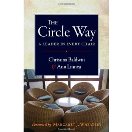 The Circle Way: A Leader in Every Chair by Christina Baldwin and Ann Linnea is a book about participating in conversations in which we can fully listen and speak to each other. The circle is an ancient social pattern, which invites participation and contribution. Because circle has been held around the common fire for thousands of years, it is remembered as a place of light and warmth. However, just as fire requires tending, the circle requires tending.
The Circle Way: A Leader in Every Chair by Christina Baldwin and Ann Linnea is a book about participating in conversations in which we can fully listen and speak to each other. The circle is an ancient social pattern, which invites participation and contribution. Because circle has been held around the common fire for thousands of years, it is remembered as a place of light and warmth. However, just as fire requires tending, the circle requires tending.
In circle, ancient ways of distributing leadership and responsibility are remembered. Leading from every chair means calling on the capacity for leadership from everyone in the circle. Everyone is accountable to everyone else as peers, and to the intention of the circle. Leading from every chair also means that it is helpful if different people host the circle over time so that leadership rotates and everyone has the opportunity to practice.
The circle’s host and guardian complement each other. As host, there is additional preparation you need to do. You need to prepare the meeting space and make sure people have what they need to participate. You also need to take care of your own preparations so that you can host the circle with “relaxed preparedness“. The host is typically responsible for the invitation and for introducing the components of circle. As guardian, you have the circle’s permission to call the circle back to its center, to ask the circle to slow down the conversation, and to remind the circle of its agreements. The guardian also works with the host to stick to the time frame of the meeting and to call for breaks when necessary.
Intention and center are the most basic circle components. Intention holds the rim, while the center holds the heart and the mindfulness of why the circle has gathered. Another important component is having an agreed time for the circle meeting, with clearly marked beginning and ending points. At the beginning each person is given uninterrupted time to check in and for the others to listen. At the end there is an exchange mirroring back what was said and heard. If the circle is the pattern, then its components are the seeds.
Calling on the willingness of everyone in the circle to participate fully is not an easy request to make. The redefinition of where leadership sits is a major shift. Leadership is understood to be a temporary authority, or as the authors put it, “a donation of one’s skills, focus, and energy so that the collective well-being is tended and the inherent wisdom in the group may emerge“. People assume increments of leadership when they willingly step into the circle, help each other, and move the conversation forward. Shared responsibility and reliance on wholeness are always in play in circle through the balancing of individual autonomy and group intent.
Part of the circle’s resilience is becoming aware of how to handle ones own vulnerability while keeping focused on the intention of the group. What I find is most impressive is that the authors explicitly address the presence of shadow and related challenges for the circle. Shadow is the covert energy residing in the group, the undiscussables. The purpose of addressing shadow is to make it overt. As soon as something is named and looked at together, it is shifted from covert to overt energy. Addressing shadow is important because it is generative in the life of circle. As long as shared intention is held and a respectful environment is maintained, conflicting points of view can ultimately be empowering and confidence building for everyone in the circle. The circle can hold shadow work as long as the circle infrastructure is maintained and there are willing leaders in every chair.
In summary, the circle allows enough room for holding the energetic presence of tension, conflict, and even shadow. The energy which is released while listening and speaking to each other enables the emergence of spontaneous and empowered action. The circle is a way to bring people together for cooperation and conversation. It is a way to be more fully human with each other. The book provides excellent guidance on how to reactivate the fundamental familiarity with circle that is lying dormant in all of us. I give the book my warmest recommendations!
This book is a great companion to The Art of Convening.
Leave a Reply
You must be logged in to post a comment.